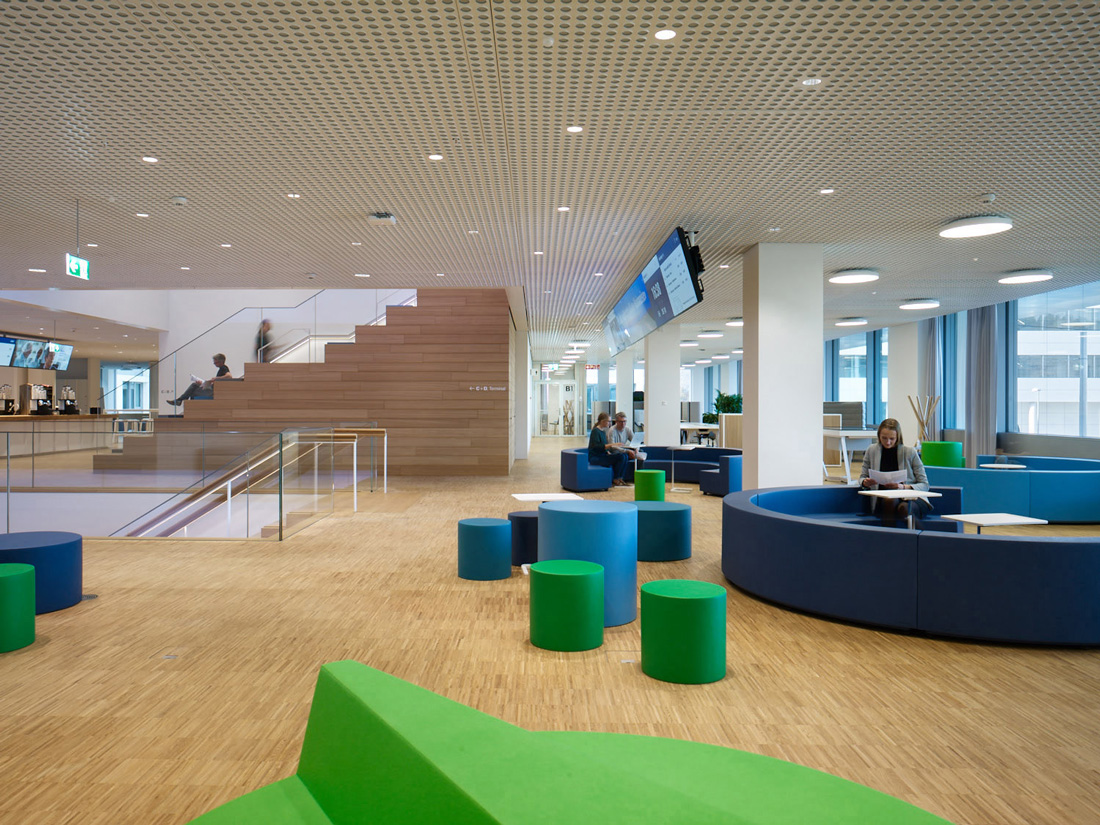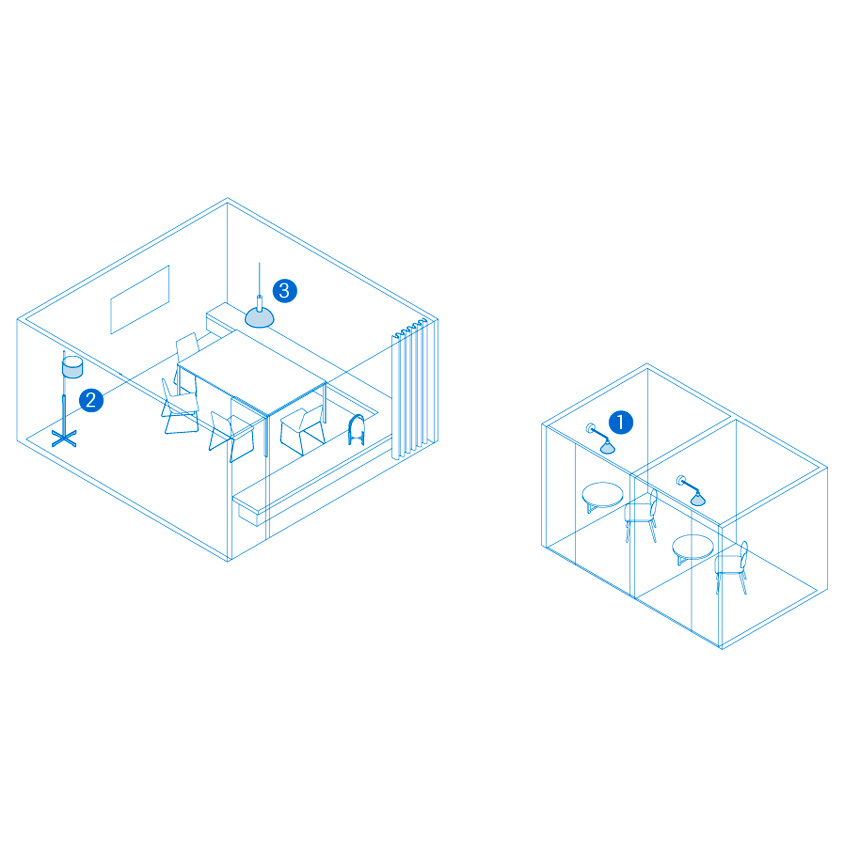
Creating atmospheres
Working with light to transform our perception of space is critical to achieve a psychologically comforting environment.
Down“Light has not just intensity, but also a vibration, which is capable of roughening a smooth material, of giving a three-dimensional quality to a flat surface.”Renzo Piano - Architect

Lighting performance for beneficial effects
New forms of regenerative light are being recognised for their beneficial effects on the body and mind. Spaces with natural light improve the function of our circadian rhythm, which can increase our happiness, energy levels and productivity. It is important to design an appropriate combination of daylight and artificial light, together with a balanced use of indirect and direct lighting.
Artificial lighting is used to define spaces according to its purpose. It should be installed only where it is needed, have a balanced intensity, and avoid glare and reflection. LED technology our standard, following K-18 Roche Group Directives. Incorporate innovative lighting solutions for a cost-efficient and energy-saving scheme.
Smart lighting control systems can regulate the intensity and colour temperature of light, mimic outdoor lighting conditions, allow individual control and drive energy savings.

Essential lighting, where to start
At the beginning of each project, lighting designers should ask the following questions for each required functional area:
- Why do we illuminate?
- What architectural, or functional significance does the room or zone have?
- What can light achieve?
- Which office tasks can be supported via lighting to optimise the use of the room?
- What is the ideal lighting solution?
- Which individual lighting strategy and methods are suitable?

The basics about lighting
There are two basic properties of light to be considered in any lighting project, which are responsible for the perception of the colour of the light, and key to the final ambience or character of a space: Colour Temperature and Chromatic Rendering Index (CRI). These properties create quality and mood, and can completely change the way we see and feel a space.
- Colour Temperature changes the ambience of a space by defining the colour of the light in range from warm to cold. It is key to consider if the space has natural light, the colour of the materials and the functional requirements to decide what kind of atmosphere should be most appropriate.
- The Chromatic Rendering Index. is a quantitative measure of the ability of a light source to reveal colours faithfully. This is critical for spaces with high visual quality requirements like laboratories but also where food is displayed. It should be >90 for main spaces and >80 for secondary spaces.

The right lighting for the right space
It is important to create differentiation in character between spaces; avoid the one-solution-fits-all approach. When choosing light temperature, consider the amount of natural light and finishes colour in a space. Combine two different temperature colours in every area to create a warm atmosphere. Light colour temperature of 4.000k for general lighting and 3.000k for ambient light are recommended.
General lighting
Creating optimal lighting requires a balanced use of light sources and materials-colours. General lighting should provide a neutral, uniform illumination to the entire space; ambient light should add comfort, support and identity to the space perception. All spaces should guarantee uniform general lighting with good visual quality. Plan a rational light layout according to the rhythm of the building’s structure. Illumination should be neutral colour, and luminaires should be the same colour as the ceiling or visually integrated with it. Adjustable general lighting systems, such as mobile lights on tracks and adjustable downlights, are advisable, as they help to achieve visual comfort and task performance in response to each user’s needs within flexible spaces. Surfaces should not be too reflective, but generally light in colour. Recommended minimum light transmission (LT) factor of 50% for walls and workspaces, 70% for ceilings, and 20% for flooring.


Open work and semi-open work areas
How does light support concentrated work? Using differentiated lighting supports productive work. A combination of visually comfortable general lighting in the background, and flexible workstation lighting for individual tasks. Add local focus of ambient. Technical characteristics: Unified Glare Rating: 19 Homogeneous Colour Temperature base specification “Neutral White” 4.000 K Work Area: 500 lux or 50 foot candles Surrounding Area: 300 lux or 30 foot candles


Enclosed work area
How does light create an optimum backdrop for all types of discussions? Open communication is supported by harmoniously lighting people’s faces in a space lit from vertical illumination spaced uniformly along the walls that create a welcoming, generous atmosphere with soft, diffuse light. Technical characteristics: Unified Glare Rating: 19 Homogeneous Colour Temperature base specification “Neutral White” 4,000 K Work Area: 500 lux or 50 foot candles. Surrounding Area: 300 lux or 30 foot candles Follow AV Standards to ensure optimum performance for video conferencing. Pay attention to background colours and lighting.

Social area
How does light foster a creative atmosphere? Creating drama with contrasts by stimulating accent lighting to emphasize interior details encourages creativity. Vertical accent lights create focal points while horizontal light accents define more private zones for reflection or intensive creative discussions. Uniform flexible general ligthing such as: • Recessed ceiling luminaires • Movable luminaires for track on track ceiling systems • Adjustable projector luminaires • Pendant linear or spot luminaires • Wall washer downlights • Other possibilities • More expressive design proposals shall be considered in the more social and collaborative areas, all supervised and approved by Roche.

Site reception / entrances / hall areas
How does light make a space inviting?
Entrance and reception areas are the first opportunities for companies to present their identity. Vertical lighting for a welcoming atmosphere in the reception area and accent light for emphasizing important elements for visitors, such as reception desks.
Technical characteristics
Unified Glare Rating: 22 Homogeneous Colour Temperature base specification “Neutral White” 4,000 K
Work Area: 100 lux or 10 foot candles.
Uniform general lighting for an inviting atmosphere: Wall washing luminaires on the perimeter walls of the room.
Recessed ceiling luminaires supporting decorative lighting such as: Adjustable projector luminaires oriented towards the welcome desk / waiting area.
Do not incorporate lighting built into the reception desk, keep it plan.


Circulation
How does light facilitate orientation?
Differentiated light helps create perception hierarchies. Linear lighting guides through the open plan space and casts precise and efficient illumination. Wall washing defines peripheral room surfaces and creates bright spatial impressions. Well-lit circulation areas enable access and promote spontaneous conversations between colleagues.
General lighting for orientation:
Illumination of vertical perimeter surfaces by wall washing lighting. Luminaires recessed from the ceiling.
Don’t
-

Avoid redundancy, or lighting with no purpose
-

Don’t use extravagant / arbitrary shaped lamps
-

Avoid excessive use of cove, indirect lighting to rooms, circulation or furniture.
Key to Creating atmospheres
- Employ adequate lighting solutions according to the use of each space.
- Stick to a clear concept for lamps typology and formal language
- Offer diversity by mixing different types of lighting for a rich atmosphere, avoid one solution fits all.
- Select the appropriate light colour temperature for space function considering natural light and finishes colours.
- All lighting fixtures should be energy efficient LED in compliance with K 18 Directive for lighting.